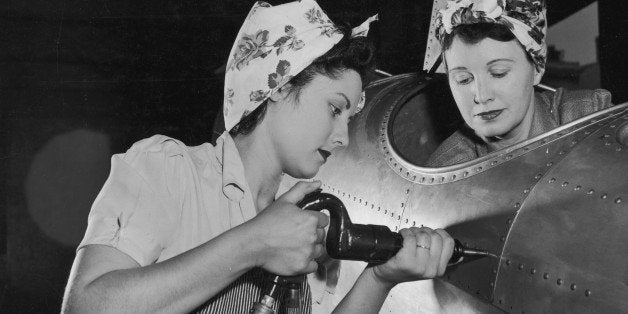
The year was 1943. World War II had been raging for years already and it was beginning to take a devastating toll on the American home front. The draft created an impossibly severe labor shortage and Secretary of War Henry L. Stimson knew that the road to victory could be paved only with more workers in American factories. "The War Department," he said, "must fully utilize, immediately and effectively, the largest and potentially the finest single source of labor available today -- the vast reserve of women power."
That quote was printed on one of the first pages of a pamphlet distributed to industrial employers as part of wartime efforts. I found the document titled simply and straightforwardly "You're Going to Hire Women" on Slate's history blog: The Vault. It is apparently going to become part of a new permanent exhibition at the National Archives.
Viewed in its entirety, the document is sometimes heartening -- "In some respects women workers are superior to men." -- and sometimes troubling -- "Women are pliant -- adaptable." But it speaks to the American mentality at the time and it offers some valuable observations still today.
"Women," the pamphlet concludes, "can be trained to do almost any job you've got."
On that point, I agree.
In fact, an article posted on DailyWorth.com just this week made the same point by sharing the stories of seven women (several of whom are members of our group, Women in Manufacturing (WiM)) who switched to manufacturing careers with no regrets and lots of success. These women arrived at manufacturing having traveled many different roads. They came from careers in education, medicine, retail and accounting. But they all came seeking a challenging and rewarding job with a good salary and flexible hours. And they all found what they were looking for in manufacturing.
There are some debates about the manufacturing sector today. Some eagerly insist that the future is bright, while others caution against early enthusiasm, saying that the current uptick pales in comparison to the massive loss of manufacturing jobs at the beginning of the 2000s.
Regardless of which attitude you hold, there are some incontrovertible truths of manufacturing today. We know that the manufacturing sector in the U.S. is growing. We know that that growth is in high-tech, high-skill, high-paying jobs. We know that there are open jobs in the manufacturing sector today and we know that more jobs will be created as companies continue to bring jobs to our shores.
We also know that manufacturing is a good place for women. A majority of women in the manufacturing sector report they are highly satisfied with careers that they find interesting, rewarding and conducive to family life.
These are the truths that we will explore at the upcoming Women in Manufacturing SUMMIT in Detroit where, by the way, manufacturing is growing as well. The SUMMIT on October 22 and 23 will be filled with timely panel and roundtable discussions as well as valuable track sessions on topics from the importance of mentorships and sponsorships (there is a difference!) to emerging issues in the manufacturing supply chain. There also will be stimulating keynote presentations from some of the biggest names in manufacturing today and some outstanding experts in the field including Carhartt, Inc., Catalyst, Caterpillar, General Motors, Rasmussen Consulting, Toyota and Wyoming Machine. This year's SUMMIT -- our third annual -- is our biggest and best ever which demonstrates a newly flourishing interest in the manufacturing sector, especially among women. The SUMMIT is for members of WiM and for women on any other path who might be considering navigating their way to manufacturing.
The final page of the WWII pamphlet is inscribed, "For maximum manpower utilization... For Victory." A WWII pamphlet, outdated in some ways today, still shows the importance of women to a 1940s American manufacturing sector. Today, thankfully, views on the role of women have changed and so has manufacturing. There is evidence of that shift in the stories of women who are currently thriving in the sector all across the country. So, reflecting on the message of that document written some 70 years ago, we are inspired to push forward with a program to attract and retain the very best female talent for the field of manufacturing today.